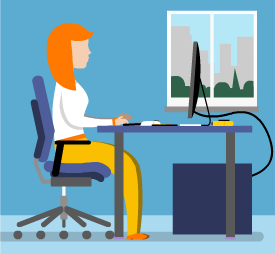

Try to keep wrists straight when typing.A space in front of the keyboard often helps for resting the hands and wrists in between typing. Adjust your keyboard so that you have a comfortable typing posture.For smaller people, a footrest might be helpful. Avoid excess pressure from the edge of your seat on the backs of your knees and legs.Make sure there is sufficient space under your desk to move your legs freely and remove any obstacles that might prevent this.Adjust curtains and blinds to prevent unwanted light and glare.
Health and safety with computers at work windows#
This will be easier if neither you nor the screen is directly facing windows or bright sunlight.

Ideally, the operator should be allowed a certain amount of discretion as to when to take breaks away from the screen The breaks are not required to be a specific length of time but the general advice is to provide more frequent, shorter ones as opposed to less, longer ones.

Provide adjustable chairs and suitable lighting.This includes the equipment, furniture, the work environment, the job being done and any special needs required by staff. Analyse VDU work stations and assess and reduce risks.VDU Health & Safety – Employers Obligations The abbreviation describes, any display screen or monitor, usually forming part of a computer, that displays text, numbers and graphics. Health Problems Arising From Bad Working Practice at VDU Equipmentĭefinition: VDU Stands For Visual Display Unit.How Can I Stay Healthy & Safe at my VDU Workstation?.VDU Health & Safety – Employers Obligations.Avoid requiring workers to conduct most of their work on a tablet device.If tablet and laptops are used as a work tool, ensure policies and procedures are in place to recommended how they should be used.If tablets and laptops are provided to workers, provide docking ports in the office with and external keyboard, mouse and adjustable height screen.Alternatively, if you elevate your laptop to view the screen properly, use an external keyboard and mouse to avoid raising your arms out of the neutral position.With laptops and tablets there is a tendency to put the device on a desk and work, requiring you to bend your neck forward to see the screen. Use a separate keyboard and a monitor that you can adjust to the right height.Stop using the device, take a break for an hour or so, or switch it off.Try using many fingers, as you would on a keyboard.Use both hands or use the other hand to give your dominant one a rest.Change positions, move around, and change postures, the less time spent in the same posture the better.Use a separate keyboard if using a tablet device for long periods.You should not be bending your neck to see the screen. Tablet devices can be put on a stand or use a cover that has a stand built in. Avoid holding the tablet in your hands for lengthy periods.


 0 kommentar(er)
0 kommentar(er)
